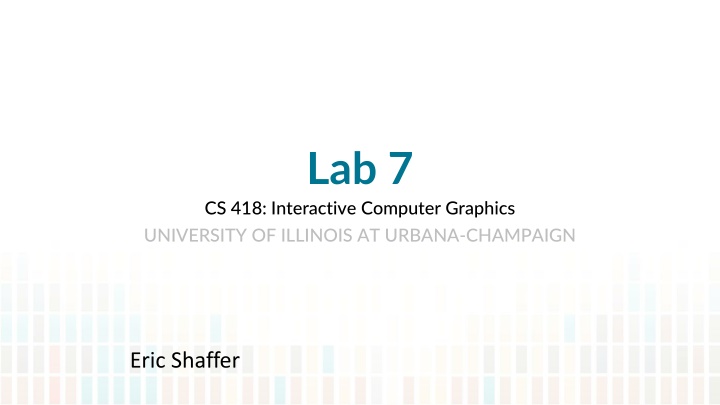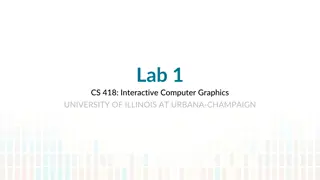
Interactive Computer Graphics at University of Illinois
Explore the world of interactive computer graphics at the University of Illinois at Urbana-Champaign, featuring examples of fog effects, distance fog implementation in WebGL and GLSL, mixing fog with colors, and debugging fog factors. Learn about flight orientation techniques using quaternions.
Download Presentation

Please find below an Image/Link to download the presentation.
The content on the website is provided AS IS for your information and personal use only. It may not be sold, licensed, or shared on other websites without obtaining consent from the author. If you encounter any issues during the download, it is possible that the publisher has removed the file from their server.
You are allowed to download the files provided on this website for personal or commercial use, subject to the condition that they are used lawfully. All files are the property of their respective owners.
The content on the website is provided AS IS for your information and personal use only. It may not be sold, licensed, or shared on other websites without obtaining consent from the author.
E N D
Presentation Transcript
Lab 7 CS 418: Interactive Computer Graphics UNIVERSITY OF ILLINOIS AT URBANA-CHAMPAIGN Eric Shaffer
Fog Fog is an example of participating media These are typically some sort of particulate Scatters and otherwise changes light There are a number of sophisticated ways to render such phenomena we ll use a simple one For something complex, check out http://www.gdcvault.com/play/1023519/Fast-Flexible-Physically-Based-Volumetric
Distance Fog Just mix a fragment color with a fog color The farther the fragment from the viewer, more fog color and less original color
Fog in WebGL and GLSL We implement fog in the fragment shader Compute the distance from fragment to camera float fogCoord = (gl_FragCoord.z/gl_FragCoord.w); And define a fog color White is a good choice especially with a white background vec4 fogColor = vec4(1.0, 1.0, 1.0, 1.0);
Mixing in Fog Use linear interpolation to mix fog with the fragment color gl_FragColor = mix(fogColor, fragColor, fogFactor ); fragColor is the color computed by your shading equation Probably Blinn-Phong The mix function is built-in GLSL function that performs lerp But what is fogFactor?
Fog Factor const float LOG2 = 1.442695; float fogDensity = 0.0005 float fogFactor = exp2( -fogDensity * fogDensity * fogCoord * fogCoord * LOG2 ); fogFactor = clamp(fogFactor, 0.0, 1.0); Fog factor determines how much of the color is fog A value of 1 means all fog in this case a value of 0 means no fog You can see the curve below we re computing GL_EXP2
Fog Factor Debugging In case you have trouble, try just implementing the linear curve for the fogFactor see if that works. Can also render your fogCoord values Compute z=fogCoord/farClipDistance; Set gl_FragColor to (z,z,z, 1.0) See if the image makes sense
Flight: Orientation Lots of ways to implement flight MP requires the use of quaternions One option to change orientation: Set up an initial view using mat4.lookat Keep a quaternion that records current orientation Each frame: Capture key presses as Euler angles Construct a temporary quaternion based on the Euler angles. quat.fromEuler in glMatrix library get current release! Update the orientation quaternion using the temp How? Update the view matrix using the orientation quaternion How?
Flight: Moving Forward Keep a user set speed factor User can adjust Move in the direction of the current orientation By speedFactor*directionVector You ll need to experiment to find appropriate speedFactor What s the current directionVector? Think about how you could compute it .

